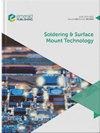The formation of intermetallic layer structure of SAC405/Cu and SAC405/ENImAg solder joint interfaces
IF 1.8
4区 材料科学
Q3 ENGINEERING, ELECTRICAL & ELECTRONIC
引用次数: 5
Abstract
Purpose The surface finish is an essential step in printed circuit boards design because it provides a solderable surface for electronic components. The purpose of this study to investigate the effects of different surface finishes during the soldering and ageing process. Design/methodology/approach The solder joints of Sn-4.0Ag-0.5Cu/Cu and Sn-4.0Ag-0.5Cu/electroless nickel/immersion silver (ENImAg) were investigated in terms of intermetallic (IMC) thickness, morphology and shear strength. The microstructure and compositions of solder joints are observed, and analyzed by using scanning electron microscopy (SEM-EDX) and optical microscope (OM). Findings Compounds of Cu6Sn5 and (Cu, Ni)6Sn5 IMC were formed in SAC405/Cu and SAC405/ENImAg, respectively, as-reflowed. When the sample was exposed to ageing, new layers of Cu3Sn and (Ni, Cu)3Sn5 were observed at the interface. Analogous growth in the thickness of the IMC layer and increased grains size commensurate with ageing time. The results equally revealed an increase in shear strength of SAC405/ENImAg because of the thin layer of IMC and surface finish used compared to SAC405/Cu. Hence, a ductile fracture was observed at the bulk solder. Overall, the ENImAg surface finish showed excellent performance of solder joints than that of bare Cu. Originality/value The novel surface finish (ENImAg) has been developed and optimized. This alternative lead-free surface finish solved the challenges in electroless nickel/immersion gold and reduced cost without affecting the performance.SAC405/Cu和SAC405/ENImAg焊点界面金属间层结构的形成
目的表面光洁度是印刷电路板设计中的一个重要步骤,因为它为电子元件提供了可焊接的表面。本研究的目的是研究不同表面光洁度在焊接和老化过程中的影响。设计/方法/方法对Sn-4.0Ag-0.5Cu/Cu和Sn-4.0Ag-0.5Cu/无电镍/浸银(ENImAg)焊点的金属间化合物(IMC)厚度、形态和剪切强度进行了研究。利用扫描电子显微镜(SEM-EDX)和光学显微镜(OM)对焊点的微观结构和成分进行了观察和分析。当样品暴露于老化时,在界面处观察到Cu3Sn和(Ni,Cu)3Sn5的新层。IMC层厚度的类似增长和与老化时间相称的晶粒尺寸的增加。结果同样揭示了SAC405/ENImAg的剪切强度的增加,这是由于与SAC405/Cu相比所使用的IMC薄层和表面光洁度。因此,在大块焊料处观察到韧性断裂。总体而言,ENImAg表面光洁度显示出比裸Cu更好的焊点性能。原始性/价值开发并优化了新型表面光洁度(ENImAg)。这种可替代的无铅表面光洁度解决了化学镀镍/浸金方面的挑战,并在不影响性能的情况下降低了成本。
本文章由计算机程序翻译,如有差异,请以英文原文为准。
求助全文
约1分钟内获得全文
求助全文
来源期刊

Soldering & Surface Mount Technology
工程技术-材料科学:综合
CiteScore
4.10
自引率
15.00%
发文量
30
审稿时长
>12 weeks
期刊介绍:
Soldering & Surface Mount Technology seeks to make an important contribution to the advancement of research and application within the technical body of knowledge and expertise in this vital area. Soldering & Surface Mount Technology compliments its sister publications; Circuit World and Microelectronics International.
The journal covers all aspects of SMT from alloys, pastes and fluxes, to reliability and environmental effects, and is currently providing an important dissemination route for new knowledge on lead-free solders and processes. The journal comprises a multidisciplinary study of the key materials and technologies used to assemble state of the art functional electronic devices. The key focus is on assembling devices and interconnecting components via soldering, whilst also embracing a broad range of related approaches.
 求助内容:
求助内容: 应助结果提醒方式:
应助结果提醒方式:


